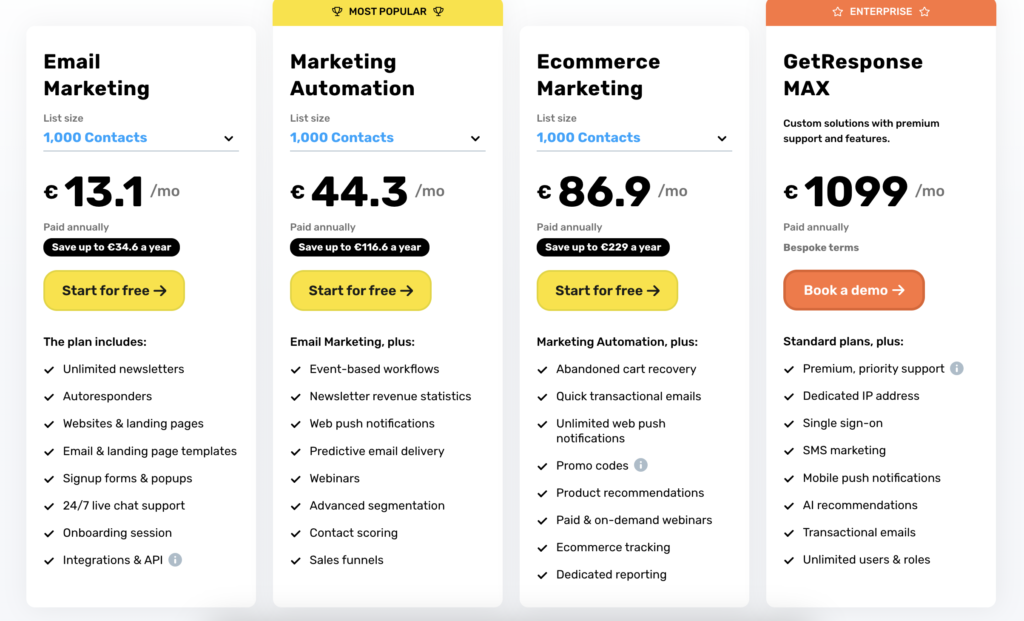When choosing the right email marketing platform, GetResponse vs AWeber is a common comparison, as both offer unique features to help businesses grow. In this guide, we’ll dive into the pros and cons, pricing, features, and user experiences of each platform to help you decide which tool best meets your marketing needs. Whether you’re after advanced automation or a beginner-friendly experience, this comparison will give you the insights you need to make an informed choice.
Table of Contents
Features
1. Email Marketing Tools
- GetResponse: Offers a flexible drag-and-drop editor with customizable templates, making it ideal for targeted campaigns.
- AWeber: Known for simplicity, it provides easy-to-use templates and a stock image library for quick, professional emails.
2. Automation
- GetResponse: Provides advanced automation workflows, perfect for creating detailed customer journeys.
- AWeber: Offers basic autoresponders, suitable for beginners but limited for advanced users.
3. Landing Pages
- GetResponse: Includes a landing page builder with customizable templates.

- AWeber: Has basic landing page options, but fewer templates.

4. Webinars
- GetResponse: Unique in offering built-in webinar hosting for engagement and lead generation.
- AWeber: Lacks webinar hosting, requiring external integrations.

GetResponse’s webinar setup.
5. Reporting and Analytics
- GetResponse: Provides in-depth analytics, tracking open rates, clicks, conversions, and more.
- AWeber: Covers essential metrics, but lacks some advanced insights.
6. Integrations
- Both platforms offer integrations, but GetResponse’s options cater more to comprehensive marketing needs, while AWeber focuses on simple workflows.
Personal Experience
1. Ease of Use
GetResponse
My experience with GetResponse was positive but involved a learning curve. Its dashboard is feature-rich, with tools like automation workflows and a landing page builder, which can be overwhelming for beginners. However, once familiar, the intuitive design makes navigation smoother.
AWeber
AWeber’s simplicity stood out. The platform was easy to set up, and I could quickly create and send campaigns without needing advanced skills. It’s ideal for users wanting to start quickly without a steep learning curve.
2. Automation Capabilities
GetResponse
GetResponse’s automation impressed me. The workflow-based design allowed me to create detailed, personalized customer journeys. Setting up conditions, tagging, and triggers made advanced automation straightforward once I got the hang of it.
AWeber
AWeber offers basic automation through autoresponders. While helpful for simple sequences, it felt limited for complex automation needs. For example, I couldn’t create in-depth workflows like I could with GetResponse.
3. Email Design and Customization
GetResponse
The drag-and-drop email editor in GetResponse allowed more customization, making it easy to design engaging emails. I enjoyed using the pre-built templates, which gave my campaigns a polished look.

AWeber
AWeber’s email editor was simpler but effective for quick designs. The template selection wasn’t as extensive, but I appreciated the ease of creating emails without too many customization options to navigate.

4. Customer Support
GetResponse
GetResponse offers 24/7 live chat support, which was helpful whenever I had questions about advanced features. The support team was responsive, and I felt well-supported.
AWeber
AWeber’s customer service, including phone support, provided a more personal experience. I found it convenient to speak directly with support for quick answers, especially as I started learning the platform.
5. Overall Performance
- GetResponse is powerful for users wanting a full-featured platform, particularly if automation, CRM tools, and webinars are priorities.
- AWeber is perfect for those seeking simplicity and ease of use, with all the essential tools to get started in email marketing.
Pricing
1. GetResponse Pricing Plans
GetResponse offers four main pricing tiers, making it flexible for businesses of all sizes:
- Free Plan: $0/month – Suitable for beginners, it includes basic email marketing for up to 500 contacts. It lacks advanced automation and webinar features but covers essential email tools.
- Email Marketing Plan: Starts at $15/month – This plan includes unlimited email sending, advanced segmentation, and autoresponders, making it suitable for small businesses.
- Marketing Automation Plan: Starts at $48/month – With access to advanced automation workflows and sales funnels, this plan is ideal for businesses focused on growth.
- Ecommerce Marketing Plan: Starts at $97/month – Designed for ecommerce businesses, this plan includes ecommerce tools, abandoned cart recovery, and more.

2. AWeber Pricing Plans
AWeber has a simpler pricing structure, with a free option and a single paid tier that scales with the number of subscribers:
- Free Plan: $0/month – Allows up to 500 subscribers, offering email templates, landing pages, and essential automation. It’s limited compared to GetResponse’s free plan but works well for basic needs.
- Pro Plan: Starts at $19.99/month – This plan scales as subscriber count increases. It includes unlimited email sending, segmentation, automation, and customer support via phone, email, and chat.


3. Annual Discounts
Both GetResponse and AWeber offer discounts on annual plans:
- GetResponse provides up to 18% off on a yearly plan and 30% off on a 2-year plan.
- AWeber offers annual discounts that can make the Pro Plan more affordable for long-term users.
Pros & Cons
Pros and Cons of GetResponse and AWeber
When choosing between GetResponse and AWeber, understanding the pros and cons of each platform helps in determining the best fit for your email marketing needs. Below is a breakdown of their advantages and limitations.
Pros and Cons of GetResponse
Pros:
- Advanced Automation: GetResponse excels in automation, allowing detailed workflows and custom triggers that help build personalized customer journeys.
- Webinar Hosting: The platform includes built-in webinar tools, making it easier to engage with audiences and drive leads through webinars without needing separate software.
- Landing Page Builder: GetResponse offers customizable landing pages with optimized templates, which is ideal for businesses focused on capturing leads.
- Comprehensive CRM Integration: Its CRM tool integrates smoothly with marketing functions, helping manage customer interactions in one place.
- Affordable Free Plan: The free plan covers up to 500 subscribers, providing beginners with essential tools.
Cons:
- Learning Curve: The platform’s feature-rich dashboard can be overwhelming for beginners, making it less ideal for those new to email marketing.
- Higher Cost for Advanced Features: To access more sophisticated tools like advanced automation and ecommerce features, users need to upgrade to higher-tier plans, which are pricier.
Pros and Cons of AWeber
Pros:
- Beginner-Friendly Interface: AWeber’s interface is simple and easy to navigate, making it perfect for new users or small businesses without advanced marketing needs.
- Strong Customer Support: AWeber provides reliable customer support, including phone, email, and chat options, which is beneficial for beginners needing guidance.
- Effective Automation Basics: While simpler, AWeber’s automation tools allow for effective autoresponders, perfect for users needing straightforward automation.
- AMP for Emails: AWeber supports AMP, allowing for interactive emails that enhance user engagement.
- Flexible Pricing with Free Plan: The free plan allows up to 500 subscribers and includes essential features, which is competitive for those starting with email marketing.
Cons:
- Limited Advanced Features: Lacking robust automation workflows and CRM, AWeber may not meet the needs of users seeking more comprehensive tools.
- Less Customizable Landing Pages: While AWeber includes landing pages, customization options are limited compared to GetResponse, making it less versatile for lead capture.
- Higher Price for Large Lists: As subscriber numbers grow, AWeber’s Pro plan can become more expensive, especially for users needing only basic features.
Conclusion
In the choice between GetResponse vs AWeber, both platforms offer excellent email marketing capabilities, but each serves different user needs.
GetResponse
GetResponse stands out for businesses seeking advanced features, such as:
- Detailed automation: Perfect for creating complex customer journeys.
- Webinar hosting: Ideal for engagement and lead generation.
- Integrated CRM: Helpful for managing customer relationships within the platform.
However, GetResponse’s feature-rich nature comes with a learning curve, and its more advanced tools are accessible at higher price tiers, making it better suited for growing businesses or users who need comprehensive marketing functions.
AWeber
AWeber is a solid choice for those who prioritize:
- Ease of use: AWeber’s interface is intuitive and simple, ideal for beginners.
- Responsive customer support: Provides phone, chat, and email support.
- Basic automation: Covers essential email marketing needs with autoresponders and interactive AMP emails.
While AWeber lacks some of the advanced tools offered by GetResponse, it’s an affordable, accessible option for smaller businesses or new marketers focused on simplicity.
Final Recommendation
Choose GetResponse if you need powerful tools like automation workflows, webinars, and a built-in CRM to support growth. Opt for AWeber if you want a straightforward, easy-to-use platform for essential email marketing with dependable support.
In summary, the decision between GetResponse and AWeber depends on your business needs. Both platforms offer value, with GetResponse catering to advanced users and AWeber being ideal for those looking for simplicity in email marketing.




